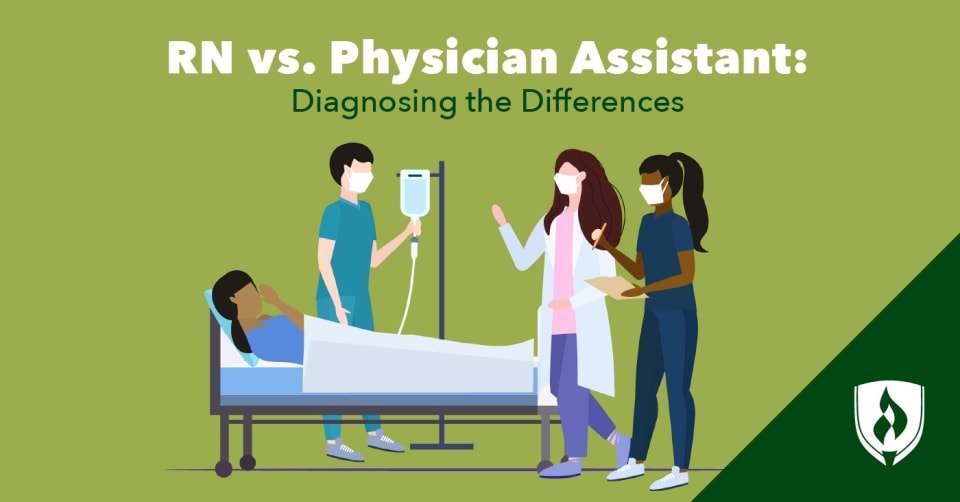
There’s no doubt about it—there’s a lot of opportunity to be found in the healthcare field. In fact, the Bureau of Labor Statistics (BLS) projects employment in healthcare occupations to grow 16 percent from 2020 to 2030—that’s roughly 2.6 million new jobs!1 As the population ages, healthcare professionals are needed in every area to meet demand. This expansive field covers a ton of ground—from surgical technologists to medical assistants and pharmacy technicians, there are numerous job titles for every skill set.
But if you’re searching for a job in the medical sector, you’ve likely come across various abbreviations and been confused. What’s the difference between an LPN and an RN? What does a CNA do? What about a DNP or LVN? While sorting this out may seem overwhelming, we’re here to help with two prominent examples—registered nurses (RNs) and physician assistants (PAs).
What’s the difference between a physician assistant and a registered nurse?
If you’re exploring a future career in healthcare and comparing registered nurses versus physician assistants, you may be unwittingly asking the wrong question for a direct comparison.
For those not familiar with the healthcare field, it’s easy to think that these two job titles are generally the same thing—after all, nurses seemingly assist physicians, so that must mean they’re similar, right? But don’t let the “assistant” portion of the PA job title mislead you into thinking this is a low-level healthcare role—the mental emphasis should focus more on physician in this title. To be clear, a physician assistant is not a physician, but works in coordination with an overseeing doctor to help with medical practice-related work.
So, what's a physician? A physician is anyone qualified to practice medicine, in other words, someone with a doctorate in medicine (MD) who is licensed to practice. Practicing medicine is a different discipline than practicing nursing. Nursing is typically focused more on caring for patients and administering treatments, while medicine focuses on diagnosis and developing treatment plans.
Knowing that, you might not be surprised that there are some pretty big differences between registered nurses and physician assistants. But there is a role within the nursing practice, nurse practitioner (NP), which is fairly similar to the role of a PA. So to help you get a more complete picture, and a closer apples-to-apples comparison, we’ve also included information about nurse practitioners in our breakdown.
RN vs. PA vs. NP: Job duties
The daily duties of any job play a huge role in determining whether or not you’ll be happy in a specific career. It’s important to remember that duties will vary depending on years of experience and job location.
RN: Registered nurses are considered by many to be the backbone of the healthcare system. They provide initial patient assessments, follow care plans, administer medications and educate both patients and their families on various health topics. However, they cannot diagnose patients or prescribe medication—a distinction from NPs and PAs.
Some RNs have job duties that aren’t focused on direct patient care. These roles often focus on quality or safety improvements, improving informatics systems, patient advocacy or nursing education.
PA: While there are distinctions to be found in the details, the work of a physician assistant is more similar to that of a doctor than of a registered nurse. Typical duties a PA can expect include examining and diagnosing patients, creating care plans, suturing lacerations, setting bones, prescribing medicine, assisting in surgery and conducting research on the latest treatments. Physician assistants can perform many of the same duties as a physician, but in many states have to report to a supervising doctor.
Physician assistants also have the opportunity to focus their practice—some choose to pursue generalist/primary care work, while others may choose to pursue a specialist track.
NP: Like PAs, nurse practitioners have a more advanced scope of practice than registered nurses. Many NP duties mirror that of a PA; however, nursing school emphasizes patient-centered medicine, while PA school focuses on disease-centered medicine. This means that physician assistants attend to the direct and immediate treatment of patients, whereas nurse practitioners focus on prevention, wellness and education. Another important distinction is that in many states, nurse practitioners are licensed to work independently without physician supervision.
Specific duties of nurse practitioners include providing hands-on patient care, creating care plans, diagnosing health problems, prescribing medication and educating patients on how to manage their health problems. Like PAs, nurse practitioners can pursue a general practice/primary care generalist focus, or specialize in fields like psychiatric mental health, pediatrics, and adult gerontology among others.
RN vs. PA vs. NP: Education requirements
As you might expect, the differences in responsibilities for these roles correlate to a difference in educational requirements. Let’s take a closer look at each.
RN: If you want to be an RN, there are two primary educational routes—an Associate’s degree in Nursing (ADN) or a Bachelor’s of Science in Nursing (BSN) degree. An associate’s degree is generally a two-year program, while a BSN typically takes four years to complete. No matter which path you take, you will need to pass the NCLEX-RN exam and meet all state licensure requirements.
PA: As physician assistants perform many of the same duties as doctors, they are required to obtain more education and training than compared to most RNs. Additionally, most PA programs require many hours of healthcare experience to be admitted. PA positions require a master’s degree in physician assistant studies, which takes about two years of full-time, graduate-level study. All PAs must earn licensure to practice. This entails completing a program accredited by the Accreditation Review Commission on Education for the Physician Assistant (ARC-PA) and passing the Physician Assistant National Certifying Examination® (PANCE) as well as meeting all other licensure requirements.
NP: Nurse practitioners need to complete the undergraduate coursework for registered nurses before beginning their journey to becoming certified NPs. After that, there are two primary pathways to becoming an NP—either a Master of Science in Nursing (MSN) Nurse Practitioner program, or through completing a Doctor of Nursing Practice (DNP) program. Once they’ve obtained an advanced degree, they must pass an exam to become licensed. For specializations such as acute care or midwifery, nurse practitioners must enroll in a direct program and then pass a more specific certification exam.
RN vs. PA vs. NP: Job outlook
You might be looking into a career in healthcare because you want to help people, but salary and job prospects are still important factors to consider. Here’s how these options stack up.
RN: Employment of registered nurses is projected to grow 9 percent by 2030, as fast as the national average for all occupations. Many of these jobs were available in outpatient centers and residential care facilities, as well as the traditional hospital settings.
PA: Employment of physician assistants is projected to grow 31 percent by 2030. With many states expecting physician shortages, several are reducing regulatory hurdles for PAs as a way to combat the issue. Another factor is the aging population—with more baby boomers needing medical attention, PAs will be needed to help diagnose and treat this sector of the population.1
NP: Though there isn’t a specific outlook for nurse practitioners, the BLS projects that employment of nurse practitioners, nurse anesthetists, and nurse midwives will grow by 45 percent by 2030. Like PAs, NPs are also called upon to provide care in some areas to ease the absence of physicians.
The bottom line
RNs, PAs and NPs are not interchangeable, but they are all appealing options for anyone interested in direct patient care. All of these roles play an incredibly important part in our healthcare system and have strong job prospects going forward. Now that you’ve got a better understanding of the differences and relationship between RNs, PAs and NPs, you can decide which route is best for you.
If you’re not sure about committing to one of the longer educational routes, that’s completely understandable. Fortunately, there’s no rule that says a registered nurse cannot become a physician assistant or nurse practitioner with more education later on in their career. If a career as a registered nurse sounds like the right move for you, check out our article “How to Become a Registered Nurse: Your Step-by-Step Guide” to learn more about what you’ll need to get started.
1Bureau of Labor Statistics, U.S. Department of Labor, Occupational Outlook Handbook, [career information accessed October, 2021] www.bls.gov/ooh/. Information represents national, averaged data for the occupations listed and includes workers at all levels of education and experience. Employment conditions in your area may vary.
EDITOR’S NOTE: This article was originally published in June 2013. It has since been updated to include information relevant to 2021.
Physician Assistant National Certifying Examination is a registered trademark of National Commission on Certification of Physician Assistants, Inc.




